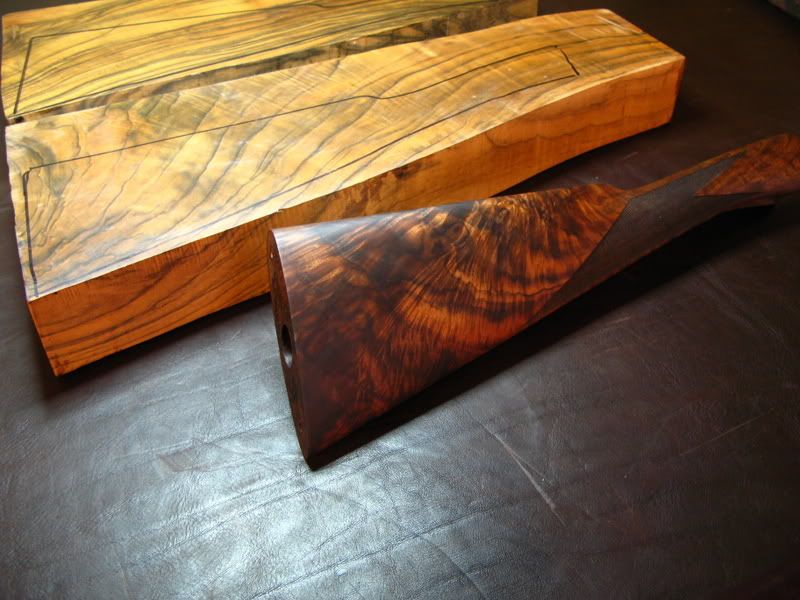|
S |
M |
T |
W |
T |
F |
S |
|
|
1
|
2
|
3
|
4
|
5
|
6
|
|
7
|
8
|
9
|
10
|
11
|
12
|
13
|
|
14
|
15
|
16
|
17
|
18
|
19
|
20
|
|
21
|
22
|
23
|
24
|
25
|
26
|
27
|
|
28
|
29
|
30
|
|
|
|
|
|
|
Forums10
Topics38,433
Posts544,712
Members14,402
| |
Most Online1,258
Mar 29th, 2024
|
|
|
|
Joined: Jun 2003
Posts: 64
Junior Member
|
OP

Junior Member
Joined: Jun 2003
Posts: 64 |
Do you notice the very fine scratches on the second pic from a bottom right to upper left curve? My last wet sanding was done with 800 grit so I'm lost as to why. It's been suggested that I re-wet-sand using tack cloth between sanding. Any ideas?  
|
|
|
|
|
Joined: Aug 2005
Posts: 1,583
Sidelock
|

Sidelock
Joined: Aug 2005
Posts: 1,583 |
Mark,
Assuming you've moved up through the sandpaper grades:
After the existing coat is completely dry, try using the 3M ultra-fine Scotchbrite pads (instead of steel wool) to work the scratches out.
BTW, the general issue you're seeing is very common on all of my projects; that the imperfections of the PREVIOUS phase (i.e. the 600 grit work on your stock) only show up when I do the 800 grit work. Two steps forward one step back !!! I guess the pro's have better eyes to find those issues before going to the next step.
Last edited by Yeti; 07/23/07 12:44 PM.
|
|
|
|
|
Joined: Apr 2005
Posts: 1,688 Likes: 31
Sidelock
|

Sidelock
Joined: Apr 2005
Posts: 1,688 Likes: 31 |
If you put scratches into the wood, you have to sand them out.It always pays to inspect and refract the light before deciding to move to the next stage.Patience is a virtue, sadly lacking in most of us.
|
|
|
|
|
Joined: Aug 2005
Posts: 1,698
Sidelock
|

Sidelock
Joined: Aug 2005
Posts: 1,698 |
Mark --- beautiful job on that lower American walnut stock ! Ken
Ken Hurst
910-221-5288
|
|
|
|
|
Joined: Aug 2005
Posts: 377
Member
|

Member
Joined: Aug 2005
Posts: 377 |
Mark,
Salopian is 10000000% right. I'd use 1000 grit next. The wood is really gorgeous! My "recipe" is 25-35 coats of Pro-Custom oil air brushed on with 1000 grit inbetween coats for the last 10-12 coats. PATIENCE!!!! Best, Dr. BILL
|
|
|
|
|
Joined: Jan 2003
Posts: 1,227
Sidelock
|

Sidelock
Joined: Jan 2003
Posts: 1,227 |
Mark,
That stock is deserving of real cut checkering, is it not?
|
|
|
|
|
Joined: Jan 2002
Posts: 3,642 Likes: 1
Sidelock
|

Sidelock
Joined: Jan 2002
Posts: 3,642 Likes: 1 |
Mark, the wood is beautiful!
I see the scratches going across the grain. Am I seeing right? Would that add to
the problem?
As stated above, patience is a must.
I used 1500 grit to finish the stock on my Ideal and it looks rather nice
now after several hand rubbed on drops of a modified "Salopian Formula"
I used. Patience.
JC(AL)
"...it is always advisable to perceive clearly our ignorance."ť Charles Darwin
|
|
|
|
|
Joined: May 2003
Posts: 221
Junior Member
|

Junior Member
Joined: May 2003
Posts: 221 |
I tried to see the scratches and can not see the problem? No visible scratches on my monitor.
Try wet sanding with alcohol 91%. I do not add water to any wood for any purpose ever again. Seem strange to me to do that when I've waited for years to stabilize the blank.
What does come through on my monitor is how pretty the wood is.
|
|
|
|
|
Joined: Jan 2006
Posts: 15,456 Likes: 86
Sidelock
|

Sidelock
Joined: Jan 2006
Posts: 15,456 Likes: 86 |
I believe he's pulling our leg...I can't see them either.
|
|
|
|
|
Joined: Apr 2002
Posts: 6,812
Sidelock
|

Sidelock
Joined: Apr 2002
Posts: 6,812 |
I believe Yeti has a good suggestion. Big difference between ScotchBrite and abrasive paper. Thousands of tiny edge scrapers. Sandpaper more analogous to golf spikes drug over the surface. No matter how fine, it's a process of tearing or plowing rather than cutting.
jack
|
|
|
|
|